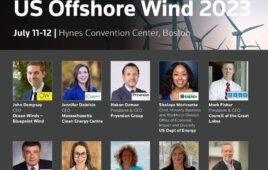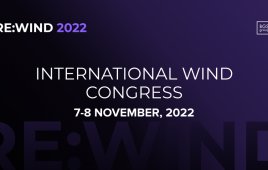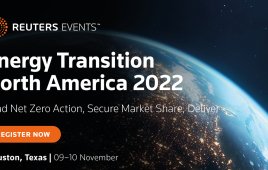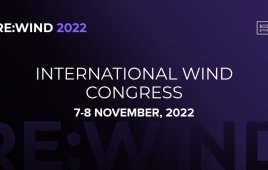The Global Wind Summit, starting in September in Hamburg, will be the biggest and one of the most important meeting of the wind industry worldwide. The event combines the wind industry expo WindEnergy Hamburg with the global conference of WindEurope to create a high-powered, unique platform for business, networking and information for the onshore and offshore industry.
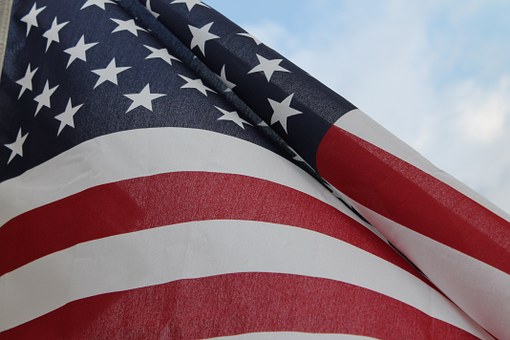
AWEA is teaming up with WindEnergy Hamburg at the Global Wind Summit this September to support the event’s USA Pavilion. To register for the conference, click here.
These two top events, the expo and the conference, will be held side by side from September 25 to 28, 2018 at the Hamburg Messe site. At WindEnergy Hamburg, which will cover nine exhibit halls, more than 1,400 exhibitors from 35 countries will present their product innovations and customized solutions for the wind industry — including all the leading international companies and specialist suppliers for the whole of the value chain.
USA Pavilion
The American Wind Energy Association (AWEA), a supporting association for the Global Wind Summit, will join stakeholders and other visitors from North America at the event. In fact, AWEA is this year’s patron of the U.S. Pavilion.
“American wind power has world-class resource potential, a robust supply chain, and a bright future that we’re excited to showcase at the WindEnergy Hamburg’s USA Pavilion,” said Brent Nussbaum, AWEA’s Vice President, Member Relations. “Land-based wind power is a competitive and mainstream energy source, supplying over 6% of U.S. electricity last year and supporting over 100,000 U.S. workers across all 50 states. Looking ahead, offshore wind is poised to take off, expanding the opportunity for workers and supply chain businesses to manufacture, deploy, and operate these projects.”
This year, WindEnergy Hamburg will put the focus on three major subjects: Dynamic Markets, Cost-Efficiency, and Smart Energy.
U.S. market leaders
Many WindEnergy Hamburg exhibitors are doing business in the U.S. Vestas, Siemens Gamesa, and Nordex Acciona, together with GE Renewable Energy captured a combined 99% for all new installed onshore turbines last year. GE’s volume product portfolio includes the latest 127-m rotor option for 2.2 to 2.5-MW rated turbines, aimed at offering a high capacity factor and reduced LCOE.
In addition, Vestas led the onshore segment with 35.4% market share and it dominated the important 2-MW+ class. The latest V116-2.2 MW for medium-wind succeeds focuses specifically at North American wind conditions. The towers, blades, nacelles, and hubs for these 2MW+ turbines are in-house produced in Colorado.
Vestas’ press officer Alexandra Thiis Billing, said: “We already have full capabilities for our increasingly popular 3 and 4-MW platforms in the U.S., and intend to produce the components for these platforms locally in future.”
Higher U.S. turbine ratings
Siemens Gamesa introduced a new 2.7-MW turbine with 129-m rotor and a new low-wind turbine for the U.S. market. It already manufactures blades of the 2.3-MW SWT-2.3-108 model in Fort Madison, Iowa), and nacelle and hub assembly in Hutchinson, Kansas. The company in 2017 expanded its blade development R&D facility for onshore and offshore of the global fleet in Boulder, Colorado, to a 50-person engineer and scientist headcount.
An ongoing global (and U.S.) market trend is for 3 to 4-MW+ ratings with matching larger rotor and hub heights. All leading OEMS will explain WindEnergy Hamburg visitors on their latest 3 and 4-MW+ onshore turbine models. Key low-wind models include the Vestas V150-4.2 MW, the latest 4.2MW Senvion 4.2M140 EBC and 4.2M148 EBC, and GE’s most powerful 4.8-MW 4.8-158 (which also features the world’s largest 158-m rotor diameter).
The Nordex Group in 2017 captured 11% of the U.S. market, and its 3-MW+ AW125 bestseller series will in 2019 to 2020 be supplemented by the AW140/3000 and N149/4.0-4.5.
“Both are our best offerings in the U.S. for achieving the lowest possible LCOE, with their product-market focus especially at densely populated low-wind regions at the U.S. East Coast,” said company spokesperson Felix Losada. “We will further construct several wind farms near the Mexican border, all with AW-type turbines put atop in-house concrete towers constructed in mobile tower plants.”
Concrete-steel hybrid tower specialist and WindEnergy Hamburg exhibitor Max Bögl Wind entered the U.S. market with its own solution offering up to 180-m hub height, and it offers mobile factories for manufacturing the concrete tower sections.
Offshore requirements
Siemens Gamesa and MHI Vestas currently dominate the world’s largest European offshore market with their 7 to 8-MW+ direct drive and 8 to 9.5-MW MHI Vestas medium-speed geared units respectively. These and experienced project developers and WindEnergy Hamburg exhibitors like Ørsted and Statoil all eye at the emerging U.S. offshore market, and will inform visitors about their current product and service offerings.
GE supplied five 6-MW Haliade, 150-6MW direct-drive turbines for the first 30-MW Block Island offshore wind farm in the U.S. A 12-MW GE Haliade X direct-drive turbine with record 220-m rotor diameter is in development, with first deliveries planned in 2021. WindEnergy Hamburg exhibitor LM Wind Power of Denmark developed the record 107-m blades.
Resolving bottleneck
Dutch marine-engineering specialist GustoMSC finally introduced a new ‘rationalized’ and Jones Act compliant jack-up design specifically focused at the emerging U.S. offshore market. It has a large open deck space and sufficient main-crane hoisting capacity for the latest 8-9.5MW offshore turbines and the foundations.
The designers for instance skipped an own propulsion system and large accommodation facilities, but retained the advanced hydraulic ‘Pin in Hole’ jacking system. Currently there is no such installation equipment available in the U.S., and GustoMSC experts will explain visitors on their range of options available for resolving this major bottleneck.
Filed Under: Events, News, Offshore wind

